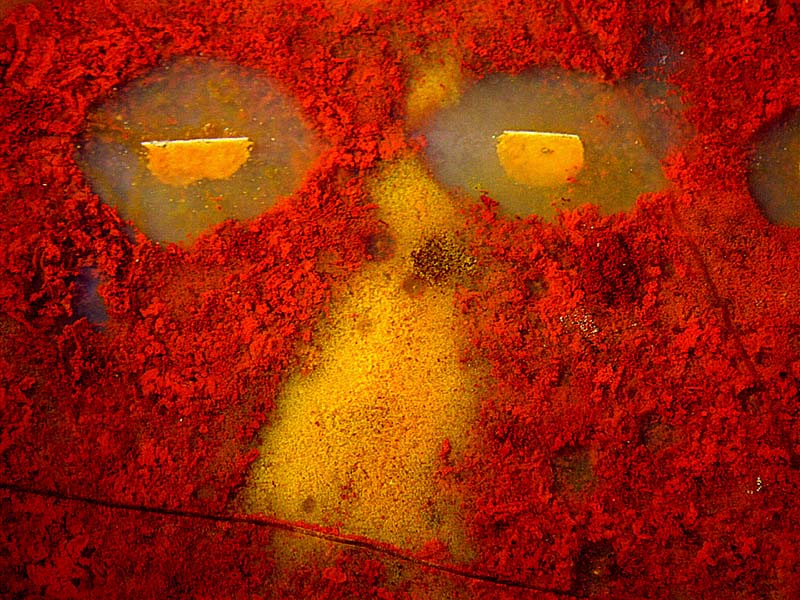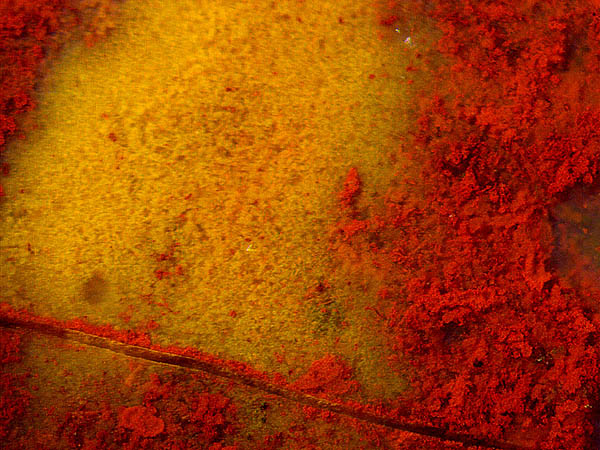Red chert ---
offering fossils and fancy artwork
 Fossils
embedded in chert may be preserved with tiny details but only a few of
the large variety of chert types offer fossils at all. Famous among
palaeontologists is the Rhynie chert since its fossils
represent an
early habitat dating back to times when the plants began to emerge from
pools and swamps and to occupy dry land.
Fossils
embedded in chert may be preserved with tiny details but only a few of
the large variety of chert types offer fossils at all. Famous among
palaeontologists is the Rhynie chert since its fossils
represent an
early habitat dating back to times when the plants began to emerge from
pools and swamps and to occupy dry land.
Some pools
and swamps with things
grown there or fallen
in became silicified by
water rich in silica
from leached volcanic "ashes".
Part of these cherts may be distinguished by red and yellow stains
due to fine-disperse iron oxides. Hence, red cherts are worth being
closely inspected in order to find out whether they are mere
accumulations of red mineral grains or stained silicified swamp matter
with
prospective fossil content.
In
this context, large amounts of red cherts from the
Döhlen basin (Lower Permian) have been inspected and partially
commented on:
Permian
Chert News 8,
14,
17,
18,
25,
27,
28,
36,
37,
38,
39.
As
a by-product of such activity, the only sample of red chert found on
the beach at Weak Law has provided surprising structures combined with
problems to be solved.
Fig.1: Apparition in red chert found on the beach at Weak Law
near Gullane, Scotland. Image
width 4.3mm.

Fig.2: "Sponge-like" yellow spot in red
chert, detail of Fig.1. Image
width 1.4mm.
From the aspect of the red
floccules in clear chalcedony (Fig.1) it may be concluded that they had
formed a suspension or loose arrangement with clear water in between.
The apparent randomness of the floccules seems to indicate that there
are no plant or animal structures involved. Clearly more uniform is the
yellow area, structured like a rubber sponge.
As a trivial fact, the
crack in Fig.2 had formed when the substance was no more fluid. Hence
the red stain along the crack, and possibly all other red stains, had
formed when the
substance was gel-like or solid. The question arises whether or not this
could be compatible with the assumption that the floccules were aggregates
of cyanobacteria whose oxygen production caused the formation and
deposition of hematite.
There
seems to be no simple explanation for the funny face in Fig.1. The
"eyeball" on the left seems to have been cleared from hematite by total
bleaching of a space with a well-defined boundary, not quite so on the
right. The thin plates
in the "eyes", tilted
towards
the cut and polished sample face, indicate some fluid level during
silicification.
The inclined sections of the plates appear as narrow
white lines, with the remaining part of the plates extending into the
depth.
The
chert sample of 10cm width and 5cm height, 0.53kg, had been a fragment
of a chert layer or lens, become slightly rounded, then embedded into
non-chert sediment. Eventually
the sediment rock
decayed and the chert came out on the beach, with
a gray 2cm-lump consisting
of two types of sediment still
sticking to the outside.
It
cannot be excluded, of course, that the pebble is not related to Weak
Law where it was found but had come along the beach from some other
place. It has tentatively been placed here among Permian cherts.
Anyway, the uncanny face may serve as a reminder that red cherts
deserve a closer look as they may offer something interesting.
H.-J.
Weiss 2022
 |
 40 40 |

 40
40 Fossils
embedded in chert may be preserved with tiny details but only a few of
the large variety of chert types offer fossils at all. Famous among
palaeontologists is the Rhynie chert since its fossils
represent an
early habitat dating back to times when the plants began to emerge from
pools and swamps and to occupy dry land.
Fossils
embedded in chert may be preserved with tiny details but only a few of
the large variety of chert types offer fossils at all. Famous among
palaeontologists is the Rhynie chert since its fossils
represent an
early habitat dating back to times when the plants began to emerge from
pools and swamps and to occupy dry land. 

 40
40